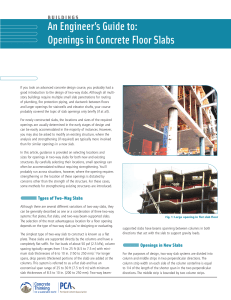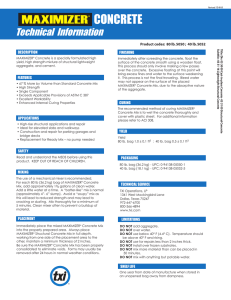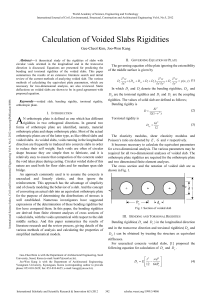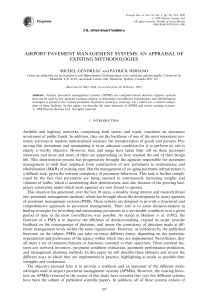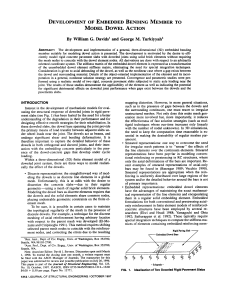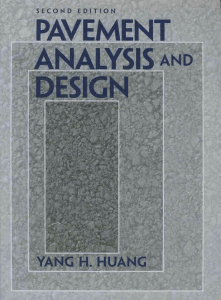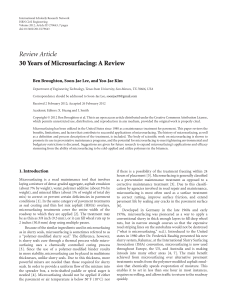Diseño de losas de hormigón con geometría optimizada Design of
Anuncio
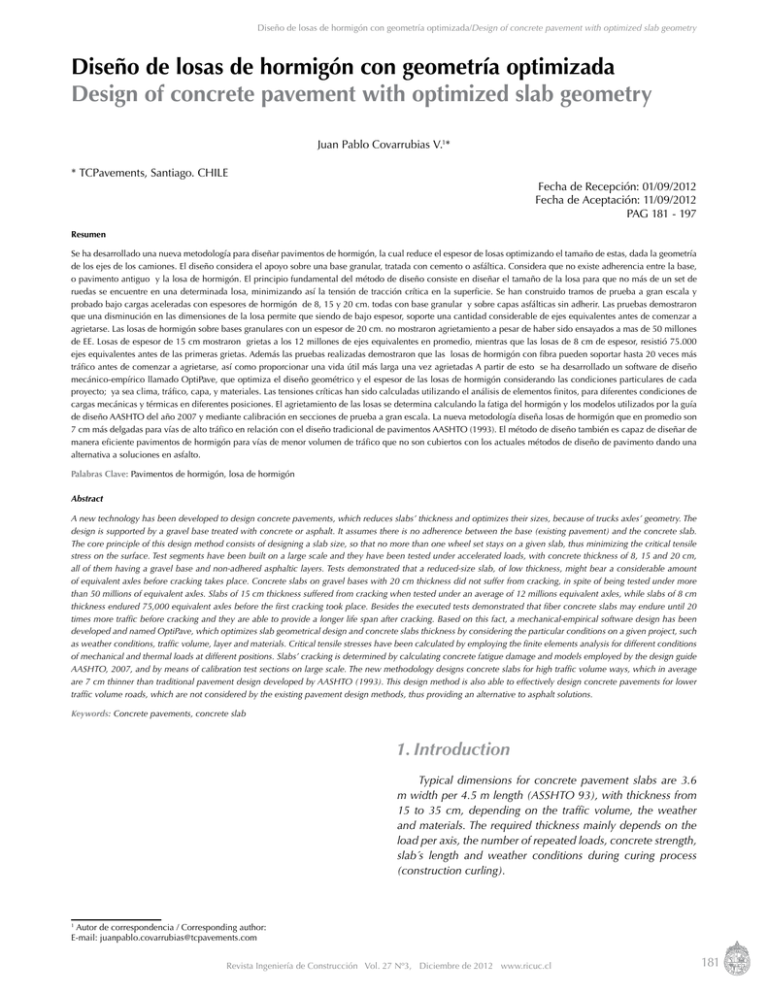
Diseño de losas de hormigón con geometría optimizada/Design of concrete pavement with optimized slab geometry Diseño de losas de hormigón con geometría optimizada Design of concrete pavement with optimized slab geometry Juan Pablo Covarrubias V.1* * TCPavements, Santiago. CHILE Fecha de Recepción: 01/09/2012 Fecha de Aceptación: 11/09/2012 PAG 181 - 197 Resumen Se ha desarrollado una nueva metodología para diseñar pavimentos de hormigón, la cual reduce el espesor de losas optimizando el tamaño de estas, dada la geometría de los ejes de los camiones. El diseño considera el apoyo sobre una base granular, tratada con cemento o asfáltica. Considera que no existe adherencia entre la base, o pavimento antiguo y la losa de hormigón. El principio fundamental del método de diseño consiste en diseñar el tamaño de la losa para que no más de un set de ruedas se encuentre en una determinada losa, minimizando así la tensión de tracción crítica en la superficie. Se han construido tramos de prueba a gran escala y probado bajo cargas aceleradas con espesores de hormigón de 8, 15 y 20 cm. todas con base granular y sobre capas asfálticas sin adherir. Las pruebas demostraron que una disminución en las dimensiones de la losa permite que siendo de bajo espesor, soporte una cantidad considerable de ejes equivalentes antes de comenzar a agrietarse. Las losas de hormigón sobre bases granulares con un espesor de 20 cm. no mostraron agrietamiento a pesar de haber sido ensayados a mas de 50 millones de EE. Losas de espesor de 15 cm mostraron grietas a los 12 millones de ejes equivalentes en promedio, mientras que las losas de 8 cm de espesor, resistió 75.000 ejes equivalentes antes de las primeras grietas. Además las pruebas realizadas demostraron que las losas de hormigón con fibra pueden soportar hasta 20 veces más tráfico antes de comenzar a agrietarse, así como proporcionar una vida útil más larga una vez agrietadas A partir de esto se ha desarrollado un software de diseño mecánico-empírico llamado OptiPave, que optimiza el diseño geométrico y el espesor de las losas de hormigón considerando las condiciones particulares de cada proyecto; ya sea clima, tráfico, capa, y materiales. Las tensiones críticas han sido calculadas utilizando el análisis de elementos finitos, para diferentes condiciones de cargas mecánicas y térmicas en diferentes posiciones. El agrietamiento de las losas se determina calculando la fatiga del hormigón y los modelos utilizados por la guía de diseño AASHTO del año 2007 y mediante calibración en secciones de prueba a gran escala. La nueva metodología diseña losas de hormigón que en promedio son 7 cm más delgadas para vías de alto tráfico en relación con el diseño tradicional de pavimentos AASHTO (1993). El método de diseño también es capaz de diseñar de manera eficiente pavimentos de hormigón para vías de menor volumen de tráfico que no son cubiertos con los actuales métodos de diseño de pavimento dando una alternativa a soluciones en asfalto. Palabras Clave: Pavimentos de hormigón, losa de hormigón Abstract A new technology has been developed to design concrete pavements, which reduces slabs’ thickness and optimizes their sizes, because of trucks axles’ geometry. The design is supported by a gravel base treated with concrete or asphalt. It assumes there is no adherence between the base (existing pavement) and the concrete slab. The core principle of this design method consists of designing a slab size, so that no more than one wheel set stays on a given slab, thus minimizing the critical tensile stress on the surface. Test segments have been built on a large scale and they have been tested under accelerated loads, with concrete thickness of 8, 15 and 20 cm, all of them having a gravel base and non-adhered asphaltic layers. Tests demonstrated that a reduced-size slab, of low thickness, might bear a considerable amount of equivalent axles before cracking takes place. Concrete slabs on gravel bases with 20 cm thickness did not suffer from cracking, in spite of being tested under more than 50 millions of equivalent axles. Slabs of 15 cm thickness suffered from cracking when tested under an average of 12 millions equivalent axles, while slabs of 8 cm thickness endured 75,000 equivalent axles before the first cracking took place. Besides the executed tests demonstrated that fiber concrete slabs may endure until 20 times more traffic before cracking and they are able to provide a longer life span after cracking. Based on this fact, a mechanical-empirical software design has been developed and named OptiPave, which optimizes slab geometrical design and concrete slabs thickness by considering the particular conditions on a given project, such as weather conditions, traffic volume, layer and materials. Critical tensile stresses have been calculated by employing the finite elements analysis for different conditions of mechanical and thermal loads at different positions. Slabs’ cracking is determined by calculating concrete fatigue damage and models employed by the design guide AASHTO, 2007, and by means of calibration test sections on large scale. The new methodology designs concrete slabs for high traffic volume ways, which in average are 7 cm thinner than traditional pavement design developed by AASHTO (1993). This design method is also able to effectively design concrete pavements for lower traffic volume roads, which are not considered by the existing pavement design methods, thus providing an alternative to asphalt solutions. Keywords: Concrete pavements, concrete slab 1.Introduction Typical dimensions for concrete pavement slabs are 3.6 m width per 4.5 m length (ASSHTO 93), with thickness from 15 to 35 cm, depending on the traffic volume, the weather and materials. The required thickness mainly depends on the load per axis, the number of repeated loads, concrete strength, slab´s length and weather conditions during curing process (construction curling). Autor de correspondencia / Corresponding author: E-mail: [email protected] 1 Revista Ingeniería de Construcción Vol. 27 Nº3, Diciembre de 2012 www.ricuc.cl 181 Juan Pablo Covarrubias In order to minimize load interaction effects and curling tensile stress, a new design methodology has been proposed for concrete slabs by means of optimizing the slab size and by defining slab geometry in accordance to the expected trucks traffic volume (Covarrubias, 2005). In this design approach, slabs sizes are chosen in such a way that only one truck´s wheel set stays on a slab. By means of a distribution of mechanical loads towards multiple slabs, tensile stresses are reduced, as well as curling stresses are decreased due to the slab size reduction. A pavement designed in such a way enables the reduction of concrete layer thickness down to 10 cm. In order to validate this new design concept, several test sections were constructed on a large scale and they were tested at the Illinois University, so as to understand the failure mode and fatigue resistance of this system. Besides, in order to spread this design concept and test results, on a large scale for a great input variables amount, tension analysis had to be completed so as to consider the cases that were not directly proven. The results from tension analyses and large scale research are presented in this paper and they are mixed by the OptiPave software design. For the use of smaller and thinner slabs sizes, the pavement design requires other modifications in order to achieve a long life span and the expected serviceability. The following list includes additional adjustments to be considered by the system: Due to the higher amount of induced contraction joints (which are intended not to be sealed), a thin cut saw sheet smaller than 2.5 mm width must be used to avoid that incompressible material enters the joint. Because of the amount of non-sealed induced contraction joints, it is necessary to count with a grave base that is less susceptible to water, which shall be able to reduce pumping probability and, consequently, reducing step faulting. The fine grave base material passing through a sieve of 75 mm shall be less than 8% and it shall have a CBR index higher than 50%. There must be a filter fabric between the base and natural soil acting as a separation layer. Such filter fabric avoids the subgrade penetration into the base, thus avoiding fine aggregates migration from the sub-grade towards the base. Because of the great amount of saw cuts, load transfer is mainly executed by aggregates rubbing at the joint; therefore, load transfer bars and tie-bars are not part of this standard design system excepting for construction joints. In order to avoid lateral displacement of thin slabs, they must be held on to the longitudinal edge with concrete shoulder, stakes (or pines) made of vertical steel or incorporating fiber structures, which have been used in previous projects. Presently, a specific load transfer system is under study for large volume designs. 182 Revista Ingeniería de Construcción Vol. 27 Nº3, Diciembre de 2012 www.ricuc.cl Diseño de losas de hormigón con geometría optimizada/Design of concrete pavement with optimized slab geometry 2.Concrete slab tensile stress Generally, conventional concrete pavements have a length from 3.5 m to 6 m, and front and rear axles simultaneously apply load near transverse joints. Such load position produces surface tensile stress on the pavement upper area, especially when the slab is curved upwards. If sections were cut in such a way the slab length prevents front or rear axles to stay simultaneously on the same slab section (Covarrubias, 2008), then slab tensile stress would be significantly reduced. Tensions and deflections calculated on Figure 1 are based on a concrete thickness of 20 cm, load of 1500 kg, and a temperature differential of -15°C. 4,5m x 1m 2.25 m x 1 m Máxima tensión de tracción= 24.65 Kg/cm2 Maximum tensile stress = 24.65 Kg/cm2 Máxima tensión de tracción = 5.22 Kg/cm2 Maximum tensile stress = 5.22 Kg/cm2 Tracciones principales en la superficie de la losa; en rojo la máxima tensión Main tensile stresses on the slab surface; red color for maximum tensile stress Deformación de la losa Slab Deflection Figure 1. Comparison between tensile stress of a mechanical and thermal loaded slab, considering 4.5 m and 2.25 Slabs´ lengths Revista Ingeniería de Construcción Vol. 27 Nº3, Diciembre de 2012 www.ricuc.cl 183 Juan Pablo Covarrubias 2.1 Load configuration for Tensile Stress Analysis In order to reduce high tensile stress caused by directional axles due to a simultaneous load, it is necessary to dimension the slab in such a way each wheel, or wheel set, is always loading a different single slab, as shown on Figure 2. As there are different configuration types of trucks axles, slab geometry is designed for the kind of truck having the most critical axle for highways use. Reduction of tensile stress on the upper slab area provides a longer life span and, a slab thickness reduction regarding traditional concrete pavement design. The finite elements program ISLAB2000 was used to build the tensile stress model showing the benefits of reducing slab dimensions and thickness as presented on Figure 2. For tensile stress configuration, the following parameters were used: 55MPa/m for k value, temperature differential of -14°C, concrete stiffness of 290,000 Kg/cm2, Poisson Coefficient of 0.25 and, thermal expansion coefficient of 1x10-5 /°C. Espesor: 25 cm de Hormigón/ Thickness: 25 cm made from concrete Losas de 4,5m x 3,6m/ Slabs 4.5m x 3.6m Máxima Tensión = 24.65 kg/cm2/ Maximum tensile stress = 24.65 kg/cm2 Espesor: 14 cm de Hormigón/ Thickness: 14 cm made from concrete Losas de 2.5m x 1.8 m/ Slabs 2.5m x 1.8 m Máxima Tensión = 24.4 kg/cm2/ Maximum tensile stress = 24.4 kg/cm2 Espesor: 16 cm de Hormigón/ Thickness: 16 cm made from concrete Losas 1.8m x 1.8 m/ Slabs 1.8m x 1.8 m Máxima tensión = 24.9 kg/cm2/ Maximum tensile stress = 24.9 kg/cm2 Espesor: 13 cm de Hormigón/ Thickness : 13 cm made from concrete Losas 1.4m x 1.8 m/ Slabs 1.4m x 1.8 m Máxima tensión = 24.6 kg/cm2/ Maximum tensile stress = 24.6 kg/cm2 Figure 2. Comparison between slabs’ dimension and thickness for maximum equivalent tensile stress on the surface The purpose of developing the design software OptiPave is to optimize the thickness and geometry of each slab for any weather condition, materials and traffic volume. In the first place, the slab size is selected in such a way only one wheel set is loading each slab, typically between 1.4 m to 2.5 m. Tensile stresses are calculated from the upper and lower slab area, for different entry conditions, i.e., thickness, curling, traffic, axle type, etc., and different load configurations, as shown on Figure 3. 184 Revista Ingeniería de Construcción Vol. 27 Nº3, Diciembre de 2012 www.ricuc.cl Diseño de losas de hormigón con geometría optimizada/Design of concrete pavement with optimized slab geometry Figura 3. Posiciones de carga consideradas por las losas como tensiones de tracción críticas. Figure 3. Slabs loading positions considered as critical tensile stresses. Based on the maximum tensile stress, on each loading position, the permitted steps for each condition (Nijk) are calculated by means of the fatigue equation MEPDG (ARA 2007) (1) Nijkl= permitted rides for an axle in k position, i curling (temperature), j loading level and critical tensile stress in the upper and lower areas. σijkl= main tensile stresses calculated by means of ISLAB2000 for axles in k position, i curling, j loading and critical tensile stress in the upper and lower areas. MOR= concrete flexure strength at 90 days C1= Correction factor for slab geometry and thickness C2= Correction factor for fiber structure C3= Correction factor for loading perimeter By employing the Miner´s hypothesis, fatigue damage is determined for each position in the slab upper and lower area based on the following formula: (2) Where: FDk= Fatigue damage for a particular position on k axle nijk= Number of rides for I local tension under i,j,k condition Nijk= Number of permitted rides for I local tension under i,j,k condition The percentage of cracked slabs is determined with 50% reliability in each upper and lower position, based on MEPDG, which is fatigue damage in the cracking model (ARA, 2007) (3) Revista Ingeniería de Construcción Vol. 27 Nº3, Diciembre de 2012 www.ricuc.cl 185 Juan Pablo Covarrubias Where: % Crackskl= Percentage of cracked slabs in k axle position FDkl= Fatigue damage with axle in k position and l stress location By combining cracking taking place in each position, it is possible to determine the pavement total fissures with 50% reliability. Tcracksl= MAX(%Crackskl) TTCracks50= Tcracksi + Tcrackss - Tcracksi * Tcrackss (4) (5) Where: TTcracks50 = % of total fissured slabs, 50% reliability Tcracksi = % of fissured slabs from the surface Tcrackss =% of fissured slabs from the inner area Reliability is determined by means of the same methodology developed by MEPDG (ARA 2007) and it is presented as follows: (6) Where: TTcracksm= % of cracked slabs, m % reliability TTcracks50= % total of cracked slabs, 50% reliability Zr = Normal standard coefficient for a given reliability level Se : Standard error 3.Validation of design concept by using an accelerated pavement test Large scale test sections for this new concrete pavement system were constructed and they were tested under accelerated load conditions by the University of Illinois. Three test sections of 40 m were constructed to determine the effects of the slabs thickness, the base stiffness and the pavement mixture on the concrete pavement behavior. Slabs were built up with 1.8 m x 1.8 m dimensions. A total of 14 slabs and joints were tested on each loading sequences. Each test section had two variables and, therefore, 7 slabs and joints were tested for each variable. 186 Revista Ingeniería de Construcción Vol. 27 Nº3, Diciembre de 2012 www.ricuc.cl Diseño de losas de hormigón con geometría optimizada/Design of concrete pavement with optimized slab geometry Neither transfer bars nor loading bars were installed; the joints were not sealed at any section. An accelerated Loading Assembly, named ATLAS, was employed to load slabs, which has 38 m length and it is well capable of testing sections of 26 m length. This accelerated test was executed in all sections until achieving a significant pavement cracking damage at medium and high severity level. Table 2 shows a summary of total equivalent axles applied on each section and the number of cracked slabs. In most of the cases, a significant overloading amount was required to reduce failure in some sections. The approximated number of Equivalent Axles applied on each section was calculated based on a step-up side traffic volume (Cervantes and Roesler, 2009). Test results showed that the 20 cm section, elaborated from concrete on a gravel base, endured the greatest amount of equivalent axles (51 millions) without showing any damage. In fact this section was loaded approximately by 7,400 wheel load rides of 157 kN and the slab sowed no damage at all. The section of 15 cm on an asphaltic layer endured 69 million of EA before a significant cracking took place, while the concrete slab of 15 cm on a gravel base endured 15 millions of equivalent axles before a relevant cracking took place. Finally, thinner slabs of 9 cm endured 75,000 EA without fiber reinforcement and 230,000 with fiber reinforcement. Table 1. Results Summary from accelerated Loading Assembly test in different sections Tipo de Base/ Base Type Ubicación de la Carga/ Load location Ejes Equivalentes Acumulados/ Cumulative Equivalent Axles Losas Quebradas (De 7 en Total)/ Cracked slabs (out of 7 in total) Valor k De la Subrasante MPa/m/ K Value of sub-grade MPa/m Sur/ South Asfalto/ Asphalt Borde/ Edge 4,4 E+07 7 68 10 cm Norte/ North Asfalto/ Asphalt Borde/ Edge 6,4 E+06 7 68 15 cm Sur/ South Asfalto/ Asphalt Borde/ Edge 3,7 E+07 1 136 15 cm Norte/ North Asfalto/ Asphalt Borde/ Edge 6,9 E+07 4 136 15 cm Sur/ South Granular/ Gravel Borde/ Edge 2,3 E+07 4 81 15cm Norte/ North Granular/ Gravel Borde/ Edge 1,7 E+07 6 27 20 cm Sur/ South Granular/ Gravel Borde/ Edge 2,0 E+07 0 41 20 cm Norte/ North Granular/ Gravel Borde/ Edge 5,1 E+07 0 27 9 Cm Sur/ South Granular/ Gravel Borde/ Edge 2,3 E+05 7 41 9 cm FRC Sur/ South Granular/ Gravel Borde/ Edge 2,3 E+05 3 41 9 Cm Norte/ North Granular/ Gravel Junta Long./ Long. Joint 4,7 E+03 7 14 9 cm FRC Norte/ North Granular/ Gravel Junta Long./ Long. Joint 6,4 E+04 4 14 Espesor/ Thickness Ubicación de La sección/ Section location 10 cm FRC: Pavimento Reforzado con Fibra Revista Ingeniería de Construcción Vol. 27 Nº3, Diciembre de 2012 www.ricuc.cl 187 Juan Pablo Covarrubias 4.Serviceability (IRI) and step faulting Pavement serviceability is a key factor for designing and maintaining pavements. The existing models used for predicting IRI are not directly applied to this new concrete pavement design concept. The IRI obtained after construction must be similar to the one obtained by a conventional concrete pavement, which mainly depends on equipment and contractor´s skills. On the other hand, IRI can be drastically affected by curling and deflections, which must be reduced with a lower slab length. One of the main considerations to be taken into account when designing TCP is step faulting in the long term. Due to its characteristics, design reduces the step faulting probabilities because of the following reasons: Slab curling produces step faulting. Pavements with TCP design have approximately one fifth of curling in comparison to a traditional pavement. This is because of the smaller slab size. Since curling is lower, step faulting and IRI are lower too. TCP pavements employ bases with less than 8% of fine aggregates. This enables bigger stones to make contact among them. Consequently, when removing fine aggregates in presence of water, there will be no volume reduction and; therefore, bearing capacity loss will not take place. Hence pumping is avoided and the base conditions are not affected at all. As the base erosion is reduced, step faulting is drastically reduced too. Since slabs are smaller, the cracking openings under cuts have a lower thickness. Such cracks have an improved load transfer, which decreases step faulting. For low and medium traffic volume, step faulting is not an expected condition due to the aforementioned reasons. When traffic volume is too heavy with too many loading cycles, a slab solution of 2.3 m length can be designed and transfer bars can be strategically installed, in case there is no step faulting risk in the long term. IRI and step faulting results for year 2010 on different concrete pavements sections built in Guatemala are shown below (Table 2). So far, more than 3,000,000 square meters have been paved using this technology, mainly in Chile, Peru and Guatemala. Among these projects there are: highways, roads and low volume pavements, streets, distribution center exterior pavements and parking lots with a minimum thickness of 8 cm. All of them were paved on gravel material or very old and deteriorated pavements. 188 Revista Ingeniería de Construcción Vol. 27 Nº3, Diciembre de 2012 www.ricuc.cl Diseño de losas de hormigón con geometría optimizada/Design of concrete pavement with optimized slab geometry Espesor (cm)/ Thickness (cm) EE de Diseño/ EA Design EE Año 2010/ EA Year 2010 IRI Inicial (m/km)/ Initial IRI (m/km) IRI Año 2010 (m/ Km)/ IRI Year 2010 (m/Km) Escalonamiento (mm)/ Step Faulting (mm) Proyecto/ Project Año de Const./ Construction year Largo Total (Km-Pista)/ Total length (KmRoad) Amatitlán Palín 2006 25,640 21 110,000,000 22,000,000 1.76 2,01 <2 San Lucas Milpas 2007 5,985 17 17,000,000 3,000,000 2.15 2,34 <2 Tecpán Los Encuentros 2009 81,217 18 20,000,000 1,111,111 - 2,07 <2 San Cristobal San Lucas 2006 21,834 17 35,000,000 8,235,294 2.1 1,72 <2 Table 2. IRI and Step Faulting Measurements Results from Projects using slab optimized geometry in Guatemala´s pavements 5. Studies on projects executed in Chile 5.1 M-50th Road, Cauquenes – Chanco M-50th Road is a road that connects Cauquenes with Chanco commune in the Maule´s Region. It was designed for 27,000,000 EA, where the concrete solution intended to employ the existing pavement mostly. This project is presently under execution and it is a contract tendered with two alternatives: asphalt having a 20 cm structure made of gravel sub-base, 20 cm of gravel base, and 8 cm of Binder and a surface of 7 cm made of modified asphalt. Concrete alternative considers a sub-base of 15 cm, which can be laid on the existing pavement or on the embankment due to geometrical modification and; a pavement of 17 cm thickness made of concrete HF 5.3 at 90 days was also considered. None draining base different to the one in the original design was employed; on short radius bends, with radius lower than 150 m, shoulders were tied to widen the pavement on structural terms, thus distancing traffic from its edge. Concrete design was developed by using the OptiPave software, which results can be observed on Figure 4. Revista Ingeniería de Construcción Vol. 27 Nº3, Diciembre de 2012 www.ricuc.cl 189 Juan Pablo Covarrubias Figure 4. Output screen of OptiPave Software for Cauquenes – Chanco design 5.2 60th Road, Chile The 60th Road connects Los Andes (Chile) to Mendoza (Argentina) and it is the main inland connection between both countries. Pavement crosses Los Andes Mountain Range at 2,000 and 3,500 meters high. The design considers 20,000,000 Equivalent Axles with a k soil of 120 Mpa/m, a non-freezing sub-base (less than 5% of fine aggregates, sieve # 200) of 45 cm thickness, which is made of crushed aggregates. Pavement thickness obtained by means of the method developed by AASHTO 1993 yielded 22 cm, with slabs of 4 m length, 3.5 m width, and flexure resistance of 5 MPa without loading transfer bars. Pavement was opened for traffic at 21 days after construction, with more than 75% of cracked slabs. The pavement failed in less than a week showing 100% of transverse cracking slabs. The section was closed for traffic in order to analyze the causes of such phenomenon. Slab curling was calculated by measuring the differences between the slabs center heights and corner heights. Such curling level corresponds to a temperature differential (Higher T°- Lower T°) at approximately 35°C. Islab2000 was employed to calculate the temperature gradient equivalent to section measurements obtained by the contractor. Temperature was calculated at the very same moment the measurement was executed, delivering a real thermal differential of +6°C, therefore, the temperature differential equivalent to the construction gradient corresponds to -41°C. The finite elements analysis showed the following stresses for different equivalent temperature differentials, as much as for construction (fixed) as environmental (variant). 190 Revista Ingeniería de Construcción Vol. 27 Nº3, Diciembre de 2012 www.ricuc.cl Diseño de losas de hormigón con geometría optimizada/Design of concrete pavement with optimized slab geometry Figure 5. Tensile Stress for an equivalent temperature differential at -6°C + -10°C Figure 6. Tensile Stress for an equivalent temperature differential at -35°C Figure 7. Tensile Stress with TCP Design for an equivalent temperature differential at -35°C By employing these stress levels and fatigue equations M-EPDG, the following table was obtained including the number of trucks rides required to produce an equivalent damage level, according to different design methods. Revista Ingeniería de Construcción Vol. 27 Nº3, Diciembre de 2012 www.ricuc.cl 191 Juan Pablo Covarrubias Tensión tracción Máxima (MPa)/ Max. Tensile Stress (MPa) Número Pasadas Necesarios (EE)/ Number of required rides (EA) Espesor Capa Hormigón (cm)/ Concrete layer thickness (cm) Largo Losa (cm)/ Slab Length (cm) Alabeo Total. (ºC)/ Total Curling (ºC) Distancia entre Ejes (cm)/ Distance between Axles (cm) Kc (MPa/m)/ Kc (MPa/m) Diseño AASHTO 4m, alabeo real(AASHTO design 4m, real curling 4.9 105 22 450 -35 350 120 Losas de 3m con eje delantero/ Slabs of 3m with front axle 3.3 1785 22 300 -35 350 120 Losas de 3m con eje trasero/ Slabs of 3m with rear axle 3.4 1329 22 300 -35 250 120 Diseño AASHTO 4m Alabeo estimado/ AASHTO design 4m estimated curling 2.2 192,028 22 450 -10 350 120 Diseño TCP/ TCP design 1.3 Infinito 22 220 -35 350 120 Diseño TCP/ TCP design 2.3 243.879 17 220 -35 350 120 Table 3. Performance and Effects of different designs when considering curling The pictures below show the pavement performance a short time after its construction. The pavement on the left was designed according to AASHTO 1993, while the pavement on the right was constructed as per TCP optimization technology. The picture´s cracks took place a few hours after traffic opening, while picture at the right side was taken 9 months after paving, showing no cracking at all. Figure 8. Cracking on a pavement designed by AASHTO with slabs of 4 m length 192 Revista Ingeniería de Construcción Vol. 27 Nº3, Diciembre de 2012 www.ricuc.cl Diseño de losas de hormigón con geometría optimizada/Design of concrete pavement with optimized slab geometry Figure 9. TCP design, 8 months after construction In order to prove the design, a construction equivalent thermal gradient of -6°C was employed by the M-E PDG delivering a 22 cm thickness, which is a result quite similar to the one delivered by AASHTO 93. If the construction equivalent thermal gradient employed by M-E PDG were the one measured at -25°C, then the thickness should have been 37 cm. The design method of TCP optimized slab geometry reduces stresses on the surface due to curling. By using the OptiPave software, the required thickness would be 17 cm. Table 4 shows a summary. M-E PDG M-E PDG K Suelo/ K Soil AASHTO 93 TCP ----- -20°C* 120 MPa/m Clima/ Weather Condition Palmdale-California Gradiente Térmico Equivalente de const./ Thermal Gradient construction equivalent. - 6°C -25°C Dimensiones losa hormigón(cm)/ Concrete Slab Dimensions (cm) 400x350 Espesor del hormigón/ Concrete thickness 22 37 22 17 Serviciabilidad/ Serviceability 10% Losas Agrietadas/ 10% Cracked Slabs 10% Losas Agrietadas/ 10% Cracked Slabs 4.5–2.5 (Pf-Pi) 10% Losas Agrietadas/ 10% Cracked Slabs 200x175 * Valor mínimo en Optipave/ * Minimum value in OptiPave Table 4. required thickness according to different methods for 60th Road Project Two 500 m – test road sections were built by employing TCP design method and using the OptiPave software. The first was a fiber reinforced concrete pavement of 15 cm thickness and, the second of 17 cm without fiber reinforcement. Revista Ingeniería de Construcción Vol. 27 Nº3, Diciembre de 2012 www.ricuc.cl 193 Juan Pablo Covarrubias Figure 10. 15 cm of fiber reinforced concrete and TCP design on 60th Road for 20,000,000 EA (2 years in service) 5.3 5th Road Talca (Chile) In the 5th Road (Talca) this concrete pavement road section was built in 1993, which has a thickness of 22 cm laid on a 20 cm concrete treated base with slabs of 4 m x 3.5 m and diverging joints. Construction curling in this particular area is equivalent to an average of -15°C (Poblete 1989). Historically, slab cracking has been quite high. In order to maintain pavement in good conditions, slabs have been replaced, which have had a variant behavior, from 1 to 2 years before cracking once again. Reasons for this premature cracking are high traffic volume (50,000,000 EA for 15 years), high construction curling and base´s stiffness. A TCP design was employed to solve this condition on a high traffic volume lane. The design was the following: • • • Removing existing slab without damaging cement treated base Laying 6cm of asphaltic base (to complete 22 cm of existing slabs) Laying 16 cm of concrete with 5,3 MPa flexo-tensile strength The stress analyses developed by ISLAB2000 for both slab geometries are seen on Figure 11, where 22 cm-slabs yielded a maximum stress of 29.9 kg/cm2 and, TCP design had a maximum stress of 22.6 kg/cm2. So far, this explains the better performance developed by TCP slabs with 6 cm thickness reduction. 194 Revista Ingeniería de Construcción Vol. 27 Nº3, Diciembre de 2012 www.ricuc.cl Diseño de losas de hormigón con geometría optimizada/Design of concrete pavement with optimized slab geometry Figure 11. Tensile stresses for a pavement of 22 cm thickness, 4 m length and 3.5 m width (29.9 kg/cm2) and TCP® slabs with 16 cm thickness and 2 m length (22.8 kg/cm2) Figure 12. 5th Road, 16 cm of concrete, TCP design for 50,000,000 EA (2.5 years in service) Revista Ingeniería de Construcción Vol. 27 Nº3, Diciembre de 2012 www.ricuc.cl 195 Juan Pablo Covarrubias 6.Conclusions A new and revolutionary design method has been introduced, which optimizes concrete slab dimensions to minimize required thickness. These short slabs between 1.4 and 2.5 m have considerably reduced the maximum tensile stress, because only one wheel set is loading each slab. With this new design concept, slabs can be designed considering a thickness of only 8 cm for low trucks traffic roads on a gravel base. This allows a thickness reduction between 4 and 10 cm in comparison to concrete pavements designed by the traditional AASHTO method, thus reducing construction investment in about 20% less than the initial cost with a similar design life span. When comparing an asphalt solution, saving percentage is quite similar. Because slabs are shorter, weather conditions are less significant provided that curling is lower and the loading transfer is increased in comparison to conventional design pavements of 4.5 m length. The OptiPave software was designed based on a finite element model and the design input corresponds to short slabs. The software was calibrated with results obtained from a test executed in Illinois, which has forecasted to a great extent the performance of pavements built 7 years ago for different traffic volumes and weather conditions. The software takes into consideration soil layers, weather conditions, concrete properties, traffic volume, construction quality (construction equivalent gradient), and reliability level and; it provides design thickness, IRI and step faulting during design life span. It also has a sensibility analysis for thickness, traffic volume, concrete resistance and soil stiffness. In Chile, pavements have been constructed with thicknesses from 8 to 22 cm, which behavior is in accordance to design expectations for the traffic volume they have endured. In Peru there are parking lots, bus stations, distribution centers and industrial pavements, all of them delivering an acceptable performance and having an initial total cost lower than original projects. In Guatemala there are more than 700kmconcrete pavement roads for heavy traffic volume and they have demonstrated a good behavior, without step faulting and showing a quite low IRI increase for more than 6 years. In total more than 3 million square meters of concrete pavements have been constructed using he optimized slab geometry system. TCP® technology (Thin Concrete Pavements), OptiPave®, and the construction of optimized thin concrete slab for pavement purposes and other rights related to such technology (software, know-how, trade secrets, commercial brands, manuals and guidelines, etc) are of exclusive property of Commercial TCPavements Ltd., and they are protected under the laws and international treaties in force for Industrial and Intellectual property rights, specifically the industrial patent Nr. 44820 in Chile, patent Nr. 7.571.581 in the United States, patent Nr. 5940 in Peru, and international application PCT/ EP2006/064732,. ©TCPavements 2005-2012, intellectual property record Nr. 166311, all rights reserved. 196 Revista Ingeniería de Construcción Vol. 27 Nº3, Diciembre de 2012 www.ricuc.cl Diseño de losas de hormigón con geometría optimizada/Design of concrete pavement with optimized slab geometry 1.Referencias/References AASHTO (1993), Guide for Design of Pavement Structures ARA Inc. (2007), Interim Mechanistic-Empirical Pavement Design Guide Manual of Practice. Final Draft. National Cooperative Highway Research Program Project 1-37A. BORDELON A., ROESLER J.R., y HILLER J.E. (2009), Mechanistic-Empirical Design Concepts for Jointed Plain Concrete Pavements in Illinois, Final Report, FHWA-ICT-09-052, Illinois Center for Transportation, University of Illinois, Urbana, IL, July 2009, 255 pp. CERVANTES V. y Roesler J.R. (2009), Performance of Concrete Pavements with Optimized Slab Geometry, Final Report, FHWAICT-09-053, Illinois Center for Transportation, University of Illinois, Urbana, IL, August 2009, 112 pp. CONTROLES Y MEDICIONES SA (2006), Reporte Evaluación de la calidad de la superficie del pavimento, Guatemala 2006 COVARRUBIAS T. J. P., Andahur D. (2006), Análisis del Comportamiento de Pavimentos Delgados en Condiciones de Carga Pesada. Modelación con Software de Elementos Finitos ISLAB 2000, Enero, 2006 COVARRUBIAS T y COVARRUBIAS V. (2008), TCP Design for Thin Concrete Pavements, 9th International Conference on Concrete Pavements, San Francisco, CA, 13 pp. COVARRUBIAS V. JUAN PABLO (2009), Optipave v 3.0 COVARRUBIAS V. JUAN PABLO, COVARRUBIAS, T y ROESLER, J.R. (2010), Design of concrete slabs with optimized geometry, Sevilla EISENMANN, J. y G. LEYKAUF (1990b), Simplified Calculation of Slab Curling Caused by Surface Shrinkage, Proceedings of the 2nd International Workshop on the Theoretical Design of Concrete Pavements, Siquenza, Spain, pp. 185-197. ERES CONSULTANTS, ISLAB (2000), Finite Element Program for the Analysis of Rigid Pavements, Version 1.1, USA, 1999. HILLER JACOB E. (2007), Development of Mechanistic-Empirical Principles for Jointed Plain Concrete Pavement Fatigue Design, University of Illinois, Ph.D thesis, Urbana, IL. HILLER J.E. y ROESLER, J.R. (2005), Determination of Critical Concrete Pavement Fatigue Damage Locations Using Influence Lines, ASCE Journal of Transportation Engineering, Vol. 131, No. 8, pp. 599-607. KOHLER E. (2010), Mediciones de IRI y Escalonamiento, Pavimentos de Losas Cortas, Guatemala, Dynatest Chile LARRAIN C. (1985), Análisis Teórico-Experimental del Comportamiento de Losas de Hormigón de Pavimentos, MSc Thesis, School of Engineering, Catholic University of Chile, 1985, 280 pp. RAO C.B., BARENBERG E.J., SNYDER M.B. y SCHMIDT S.K. (2001), Effects of Temperature and Moisture on the Response of Jointed Concrete Pavements. Proc. 7th International Conference on Concrete Pavements, Vol. 1, Orlando, FL, 23-38. Revista Ingeniería de Construcción Vol. 27 Nº3, Diciembre de 2012 www.ricuc.cl 197


